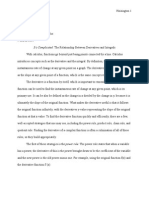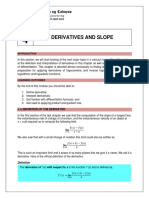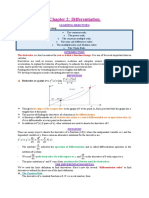Note Differentiation Formulas
Uploaded by
Siti Khadijah Mohd ZainNote Differentiation Formulas
Uploaded by
Siti Khadijah Mohd ZainDifferentiation Formulas 1. 2. 3.
Derivative of a Constant Function
d (c ) = 0 dx
d n ( x ) = nx n 1 dx
The Power rule : If n is a any real number, then
The Constant Multiple Rule. If c is a constant and f is a differentiable function, then
d d (cf ( x)) = c f ( x) dx dx
4.
The Sum Rule. If f and g are both differentiable, then
d d d [ f ( x) + g ( x)] = f ( x) + g ( x) dx dx dx
5. The Difference rule. If f and g are both differentiable, then
d d d [ f ( x) g ( x)] = f ( x) g ( x) dx dx dx
6. The Product Rule. If f and g are both differentiable, then
d d d [ f ( x) g ( x)] = f ( x) [ g ( x)] + g ( x) [ f ( x)] dx dx dx
7. The Quotient Rule. If f and g are both differentiable, then
d f ( x) [ ]= dx g ( x)
g ( x)
d d [ f ( x)] f ( x) [ g ( x)] dx dx 2 [ g ( x )]
Tutorial (Ex. 3.2, Salas) The Derivative as a Rate of Change For a differentiable function f(x), the gradient or slope of a tangent line at the point x, gives the average rate of change of y with respect to x. Example: We have a right circular cylinder of changing dimensions. Volume of the cylinder is given by V = r 2 h . (i) If h remains constant while r changes, then V is a function of r. The rate of change of V with respect to h is the derivative (ii)
dV = 2rh . dr
If r remains constant while h changes, then V is a function of h. Write down the rate of change of V with respect to h.
(iii) (iv)
If r is changing but V remains constant. Write an expression for the rate of change of h in terms of r and V. If h is changing but V remains constant. Write an expression for the rate of change of r in terms of h and V.
Velocity and Acceleration An object moves along a straight line and at each time t during a certain, the object has position x(t). The average velocity of the object at time t
x ' (t ) = lim
x( t + h ) x( t ) h 0 h
what is the acceleration a(t) in terms of x(t). what is the difference between speed and velocity? Example: An object moves along the x-axis, its position at each time, t is given by the function
x(t ) = t 3 12t 2 + 36t 27
(i) Plot the motion of the object in GSP (ii) Describe the position of the object from time t = 0, to t = 9. (iii) Find the velocity of the object. Plot the graph of the velocity. Find the time interval when the velocity is positive, o and negative (iv) Find the acceleration. Plot the graph of acceleration. Find the time interval when the acceleration is positive, o and negative (You should be able to complete your KKBI GSP Project now) Tutorial (Salas: Ex 3.4, pg 157) Derivatives of Higher Order When we differentiate the function f we get the derivative of f , f ' (f prime) is the first derivative of f . If we continue to differentiate we will get second, third , forth and so on derivatives, denoted by f , f ' , f '' , f ''' , f ( 4 ) Using Leibniz notation, we write
dy d 2 y d dy d 3 y d d 2 y = = , , dx dx 2 dx dx dx 3 dx dx 2
Tutorial (Ex.3.3, Salas,pg 147)
You might also like
- Black Cinema Visual Culture Art and Politics in The 21st Century (Artel Great, Ed Guerrero)No ratings yetBlack Cinema Visual Culture Art and Politics in The 21st Century (Artel Great, Ed Guerrero)181 pages
- Chapter11 Differentiation 151003160732 Lva1 App6891No ratings yetChapter11 Differentiation 151003160732 Lva1 App689129 pages
- Differentiation: Rate of Change of A Function at A PointNo ratings yetDifferentiation: Rate of Change of A Function at A Point6 pages
- Definition of Derivative Function: DifferentiationNo ratings yetDefinition of Derivative Function: Differentiation6 pages
- CS132Module3 Calculus EssentialNotes by DMiguelNo ratings yetCS132Module3 Calculus EssentialNotes by DMiguel3 pages
- Chapter 2. Differentiation: Vietnam National University - Hochiminh City International UniversityNo ratings yetChapter 2. Differentiation: Vietnam National University - Hochiminh City International University78 pages
- Derivative Basic-Differentiation Rules Up Rates of Change from-SBNo ratings yetDerivative Basic-Differentiation Rules Up Rates of Change from-SB26 pages
- Introduction_to_differentiation telegram notesNo ratings yetIntroduction_to_differentiation telegram notes35 pages
- MTPDF3 The Derivatives Basic Differentiation Rules and The Chain Rule PDFNo ratings yetMTPDF3 The Derivatives Basic Differentiation Rules and The Chain Rule PDF38 pages
- Differentiation: For Business, Economics, and The Life and Social SciencesNo ratings yetDifferentiation: For Business, Economics, and The Life and Social Sciences27 pages
- Derivatives and Slope: Pamantasan NG CabuyaoNo ratings yetDerivatives and Slope: Pamantasan NG Cabuyao7 pages
- 07 Applications of Derivative and The DifferentialNo ratings yet07 Applications of Derivative and The Differential63 pages
- 00 MA-C1 Booklet 01 - Intro to DifferentiationNo ratings yet00 MA-C1 Booklet 01 - Intro to Differentiation49 pages
- UMaths Unit 3 Derivatives and DifferentiationNo ratings yetUMaths Unit 3 Derivatives and Differentiation27 pages
- Peperiksaan Semester 1 Matematik Tahun 5 Kertas 2 015/2No ratings yetPeperiksaan Semester 1 Matematik Tahun 5 Kertas 2 015/23 pages
- Proposal Project Title:: Ishockedu A Software That Protect Your Laptop From Being StolenNo ratings yetProposal Project Title:: Ishockedu A Software That Protect Your Laptop From Being Stolen3 pages
- Database Management System and Design: Questions 1No ratings yetDatabase Management System and Design: Questions 18 pages
- Business Environment-Unit 1 (MBA Sem I)No ratings yetBusiness Environment-Unit 1 (MBA Sem I)75 pages
- Online Learning: A Panacea in The Time of COVID-19 Crisis: Shivangi DhawanNo ratings yetOnline Learning: A Panacea in The Time of COVID-19 Crisis: Shivangi Dhawan18 pages
- 475-20 DC Dielectric Test Set - Version 5.0No ratings yet475-20 DC Dielectric Test Set - Version 5.031 pages
- An Overview of Tribal Population in India: Tribal Health Bulletin, Special Issue 2014No ratings yetAn Overview of Tribal Population in India: Tribal Health Bulletin, Special Issue 2014131 pages
- Reader's Notebook Journey's Book Grade 2 Unit 3 WorkbookNo ratings yetReader's Notebook Journey's Book Grade 2 Unit 3 Workbook76 pages
- (LN) The Gal Is Sitting Behind Me, and Loves Me - Volume 02 (JNCodex)No ratings yet(LN) The Gal Is Sitting Behind Me, and Loves Me - Volume 02 (JNCodex)251 pages
- Powerful Hero Dpa Rtsal Protective DeityNo ratings yetPowerful Hero Dpa Rtsal Protective Deity50 pages
- RPS Matakuliah Literature in Language Education Pasca 2020No ratings yetRPS Matakuliah Literature in Language Education Pasca 202010 pages































































































